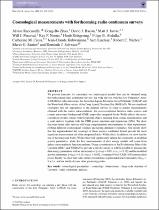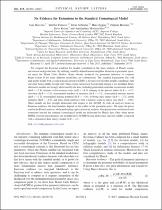JavaScript is disabled for your browser. Some features of this site may not work without it.
- ResearchSpace
- →
- Research Publications/Outputs
- →
- Journal Articles
- →
- View Item
| dc.contributor.author |
Raccanelli, A

|
|
| dc.contributor.author |
Zhao, G-B

|
|
| dc.contributor.author |
Bacon, DJ

|
|
| dc.contributor.author |
Jarvis, MJ

|
|
| dc.contributor.author |
Percival, WJ

|
|
| dc.contributor.author |
Norris, RP

|
|
| dc.contributor.author |
Rottgering, H

|
|
| dc.contributor.author |
Abdalla, FB

|
|
| dc.contributor.author |
Cress, CM

|
|
| dc.contributor.author |
Kubwimana, J-C

|
|
| dc.contributor.author |
Lindsay, S

|
|
| dc.contributor.author |
Nichol, RC

|
|
| dc.contributor.author |
Santos, MG

|
|
| dc.contributor.author |
Schwarz, DJ

|
|
| dc.date.accessioned | 2015-05-25T10:50:57Z | |
| dc.date.available | 2015-05-25T10:50:57Z | |
| dc.date.issued | 2012-08 | |
| dc.identifier.citation | Raccanelli, A, Zhao, G-B, Bacon, DJ, Jarvis, MJ, Percival, WJ, Norris, RP, Rottgering, H, Abdalla, FB, Cress, CM, Kubwimana, J-C, Lindsay, S, Nichol, RC, Santos, MG and Schwarz, DJ. 2012. Cosmological measurements with forthcoming radio continuum surveys. Monthly Notices of the Royal Astronomical Society, vol 424(2), pp 801-819 | en_US |
| dc.identifier.issn | 0035-8711 | |
| dc.identifier.uri | http://hdl.handle.net/10204/7971 | |
| dc.description | Copyright: 2012 Oxford University Press | en_US |
| dc.description.abstract | We present forecasts for constraints on cosmological models that can be obtained using the forthcoming radio continuum surveys: the wide surveys with the Low Frequency Array (LOFAR) for radio astronomy, theAustralian SquareKilometreArray Pathfinder (ASKAP) and theWesterbork Observations of the Deep Apertif Northern Sky (WODAN).We use simulated catalogues that are appropriate to the planned surveys in order to predict measurements obtained with the source autocorrelation, the cross-correlation between radio sources and cosmic microwave background (CMB) maps (the integrated Sachs–Wolfe effect), the crosscorrelation of radio sources with foreground objects resulting from cosmic magnification, and a joint analysis together with the CMB power spectrum and supernovae (SNe). We show that near-future radio surveys will bring complementary measurements to other experiments, probing different cosmological volumes and having different systematics. Our results show that the unprecedented sky coverage of these surveys combined should provide the most significant measurement yet of the integrated Sachs–Wolfe effect. In addition, we show that the use of the integrated Sachs–Wolfe effect will significantly tighten the constraints on modified gravity parameters, while the best measurements of dark energy models will come from galaxy autocorrelation function analyses. Using a combination of the EvolutionaryMap of the Universe (EMU) and WODAN to provide a full-sky survey, it will be possible to measure the dark energy parameters with an uncertainty of {s(w0)=0.05, s(wa)=0.12} and themodified gravity parameters {s( 0) = 0.10, s(µ0) = 0.05}, assuming Planck CMB+SN (current data) priors. Finally, we show that radio surveys would detect a primordial non-Gaussianity of f NL =8 at 1s, and we briefly discuss other promising probes. | en_US |
| dc.language.iso | en | en_US |
| dc.publisher | Oxford University Press | en_US |
| dc.relation.ispartofseries | Workflow;10443 | |
| dc.subject | Cosmological parameters | en_US |
| dc.subject | Cosmology | en_US |
| dc.subject | Radio continuum | en_US |
| dc.subject | Cosmological models | en_US |
| dc.subject | Galaxies | en_US |
| dc.subject | Cosmological measurements | en_US |
| dc.subject | Cosmic microwave background | en_US |
| dc.subject | CMB | en_US |
| dc.subject | Low frequency array | en_US |
| dc.subject | LOFAR | en_US |
| dc.title | Cosmological measurements with forthcoming radio continuum surveys | en_US |
| dc.type | Article | |
| dc.identifier.apacitation | Raccanelli, A., Zhao, G., Bacon, D., Jarvis, M., Percival, W., Norris, R., ... Schwarz, D. (2012). Cosmological measurements with forthcoming radio continuum surveys. http://hdl.handle.net/10204/7971 | en_ZA |
| dc.identifier.chicagocitation | Raccanelli, A, G-B Zhao, DJ Bacon, MJ Jarvis, WJ Percival, RP Norris, H Rottgering, et al "Cosmological measurements with forthcoming radio continuum surveys." (2012) http://hdl.handle.net/10204/7971 | en_ZA |
| dc.identifier.vancouvercitation | Raccanelli A, Zhao G, Bacon D, Jarvis M, Percival W, Norris R, et al. Cosmological measurements with forthcoming radio continuum surveys. 2012; http://hdl.handle.net/10204/7971. | en_ZA |
| dc.identifier.ris | TY - Article AU - Raccanelli, A AU - Zhao, G-B AU - Bacon, DJ AU - Jarvis, MJ AU - Percival, WJ AU - Norris, RP AU - Rottgering, H AU - Abdalla, FB AU - Cress, CM AU - Kubwimana, J-C AU - Lindsay, S AU - Nichol, RC AU - Santos, MG AU - Schwarz, DJ AB - We present forecasts for constraints on cosmological models that can be obtained using the forthcoming radio continuum surveys: the wide surveys with the Low Frequency Array (LOFAR) for radio astronomy, theAustralian SquareKilometreArray Pathfinder (ASKAP) and theWesterbork Observations of the Deep Apertif Northern Sky (WODAN).We use simulated catalogues that are appropriate to the planned surveys in order to predict measurements obtained with the source autocorrelation, the cross-correlation between radio sources and cosmic microwave background (CMB) maps (the integrated Sachs–Wolfe effect), the crosscorrelation of radio sources with foreground objects resulting from cosmic magnification, and a joint analysis together with the CMB power spectrum and supernovae (SNe). We show that near-future radio surveys will bring complementary measurements to other experiments, probing different cosmological volumes and having different systematics. Our results show that the unprecedented sky coverage of these surveys combined should provide the most significant measurement yet of the integrated Sachs–Wolfe effect. In addition, we show that the use of the integrated Sachs–Wolfe effect will significantly tighten the constraints on modified gravity parameters, while the best measurements of dark energy models will come from galaxy autocorrelation function analyses. Using a combination of the EvolutionaryMap of the Universe (EMU) and WODAN to provide a full-sky survey, it will be possible to measure the dark energy parameters with an uncertainty of {s(w0)=0.05, s(wa)=0.12} and themodified gravity parameters {s( 0) = 0.10, s(µ0) = 0.05}, assuming Planck CMB+SN (current data) priors. Finally, we show that radio surveys would detect a primordial non-Gaussianity of f NL =8 at 1s, and we briefly discuss other promising probes. DA - 2012-08 DB - ResearchSpace DP - CSIR KW - Cosmological parameters KW - Cosmology KW - Radio continuum KW - Cosmological models KW - Galaxies KW - Cosmological measurements KW - Cosmic microwave background KW - CMB KW - Low frequency array KW - LOFAR LK - https://researchspace.csir.co.za PY - 2012 SM - 0035-8711 T1 - Cosmological measurements with forthcoming radio continuum surveys TI - Cosmological measurements with forthcoming radio continuum surveys UR - http://hdl.handle.net/10204/7971 ER - | en_ZA |








